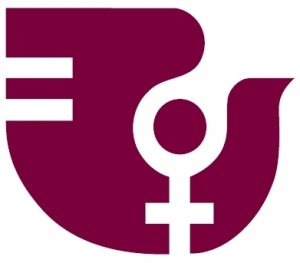Access to Abortion:
An International Human Rights Perspective on Canadian Law

Logo, UN Committee on the Elimination of Discrimination against Women (CEDAW)
By Isabel Dávila, J.D. candidate, Osgoode Hall Law School
Canadian abortion policy historically derives both from case law and international instruments. In 1969, Parliament partially legalised abortion under s. 251 of the Criminal Code, which permitted abortion as long as a Therapeutic Abortion Committee decided the abortion was necessary for the woman’s health. In 1981, Canada ratified the UN Convention on the Elimination of All Forms of Discrimination Against Women (CEDAW), which sets out a woman’s right to reproductive choice, although it does not specifically refer to a right to abortion.
The ratification of CEDAW was followed shortly by the 1982 adoption of the Canadian Charter of Rights and Freedoms. The Charter, combined with CEDAW and other new legal developments, opened up the possibility of a Supreme Court challenge to Canadian abortion laws. This challenge was eventually launched by famed Montreal physician Henry Morgentaler in the late 1980’s.
Dr. Morgentaler had founded the first freestanding clinic to offer safe abortion services in Canada in 1968. In 1970, the clinic was raided by police and he was charged with performing illegal abortions. Over the following decades, he was charged several times more, at one point serving ten months in jail. Then, in R v Morgentaler [1988] 1 SCR 30, Morgentaler’s appeal of his most recent criminal conviction led the Supreme Court to strike down s. 251 of the Criminal Code. This meant the full decriminalization of abortion in Canada.
Nevertheless, women continue to face many barriers to accessing abortion. According to constitutional law expert Martha Jackman,
Few Canadian hospitals provide abortion services, with most of these located in urban areas near the US border. The process for obtaining an abortion, wait-times, gestational limits, and the availability of counselling services vary greatly between provinces/territories and from hospital to hospital. Uninformed and anti-choice hospital staff members and health care professionals create additional barriers for women seeking abortions.[1]
Similarly, in 2016, the CEDAW Committee, a UN human rights body that monitors implementation of the CEDAW Convention, raised concerns that, even as Canada had taken “measures taken to facilitate access to legal abortion services,” there remained significant disparities in access across the country. The Committee recommended that Canada: “a) Ensure access to legal abortion services in all provinces and territories; [and] b) Ensure that the invocation of conscientious objection by physicians does not impede women’s access to legal abortion services.”
Other UN human rights bodies have declared that the denial of abortion can constitute a form of torture under the UN Convention Against Torture (CAT), which Canada ratified in 1987. In April 2016, the UN Working Group on Discrimination Against Women in Law and in Practice observed that “[i]n some situations, failure to protect women’s rights to health and safety may amount to cruel, inhuman or degrading treatment or punishment or torture, or even a violation of their right to life.” Furthermore, “[t]he Committee Against Torture and the Human Rights Committee have determined that, in some cases, being forced to carry an unwanted pregnancy to term amounts to cruel and inhuman treatment.” More recently, the CEDAW Committee’s general recommendation No. 35 stated,
[v]iolations of women’s sexual and reproductive health and rights, such as […] denial or delay of safe abortion and post-abortion care, […] abuse and mistreatment of women and girls seeking sexual and reproductive health information, goods and services, are forms of gender-based violence that, depending on the circumstances, may amount to torture or cruel, inhuman or degrading treatment.
Thus, there is a significant possibility that Canada’s current practice on the provision of abortion services does not comply with its international human rights obligations. (For more on the role of international law in the domestic context, readers are encouraged to check out a recent CLAIHR overview on applying international law in Canada.)
Improving Access
Several jurisdictions in Canada have implemented plans to improve access to abortion. Ontario passed a bill in late 2017 to forbid anti-abortion protests near clinics, with the aim of protecting patients from harassment and violence. In September, the premier of Nova Scotia announced a plan to implement universal cost coverage for the medical abortion drug Mifegymiso; since November 2017, women are now able to access reimbursement for the cost of the pill. This brings Nova Scotia in line with existing policies in New Brunswick and Alberta.
The Canadian government can also take action to continue these positive trends by ensuring that provinces meet the country’s international human rights obligations. While the division of powers means that the federal government cannot enact abortion service laws specific to every province, it can provide general guidance, in accordance with sections 3, 4, and 22(1) of the Canada Health Act. Health Canada has recently exercised this power by announcing changes to how Mifegymiso is prescribed and dispensed nationwide.
In their advocacy for more accessible abortion services, many Canadian civil society organisations have called on the federal government to develop a national gender equality plan addressing all forms of discrimination against women and girls, including access to abortion services. The Native Women’s Association of Canada has documented some of the most serious challenges:
We are very concerned about access to abortion, including access to both medical and surgical abortions, particularly in rural and northern areas. Canada is one of the only countries with a public health care system that does not have a national pharmacare program. Because of the cost of some drug regimes, this has penalizing effects for certain groups of women, including pregnant women seeking medical abortions and women with HIV.
The provision of general minimal guidelines for provinces would help satisfy these concerns by improving Canada’s compliance with several UN recommendations on women’s human rights. Federal guidance could also help to address the issue of disparate services and protection across the country.
Whatever steps come next, it is clear that, despite the legal provision for abortion, its actual provision remains limited and inconsistent nationwide. As civil society and academia call for further access, Canada remains at serious risk of violating its international human rights obligations.
ID
[1] Martha Jackman, “The Future of Health Care Accountability: A Human Rights Approach” 47 Ottawa L. Rev. 437


